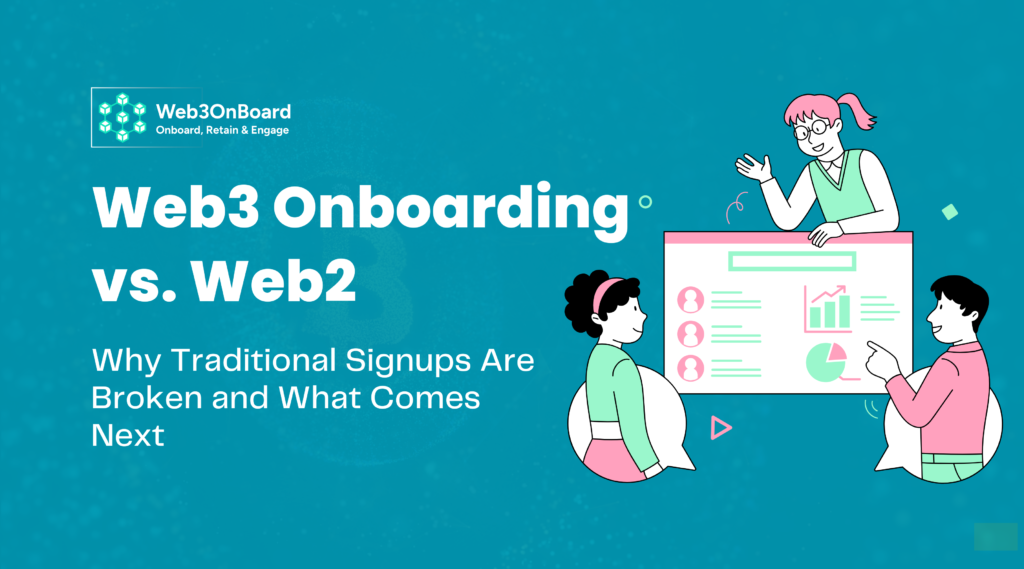Web3 Onboarding vs. Web2: Why Traditional Signups Fail

Remember the Last Time You Forgot a Password?
You go to log in.
The site asks for your password. You try one—wrong. Try another—wrong again.
Now you’re stuck in a loop: Reset password > Check email > Click link > Create a new password (that you’ll probably forget again).
It’s frustrating. And it’s a waste of time.
Now, imagine logging into a platform without ever needing a password. No email verification. No security questions asking where your childhood pet is buried. Just instant, seamless access—because you own your credentials.
That’s the promise of Web3 onboarding. But before we dive into how it works, let’s talk about why Web2 signups are broken beyond repair.
Why Traditional Signups No Longer Work
For decades, Web2 companies have relied on the same outdated onboarding system:
- Create an account with an email and password
- Verify email by clicking a link
- Set up two-factor authentication for security
- Save your password somewhere (or forget it and reset it later)
Sounds simple, right?
It’s not. It’s annoying. And people hate it.
1. Password Fatigue is Real
Studies show that the average internet user has over 100 passwords. Who can remember all that?
So, people take shortcuts. They reuse passwords. Use weak ones. Forget them entirely.
That’s why hackers love traditional logins. 81% of data breaches happen due to weak or stolen passwords. And once your data is compromised, you can’t take it back.
2. Too Many Hoops to Jump Through
The more steps you add to a signup flow, the fewer people actually complete it.
- CAPTCHA challenges (Are you a robot? Click the traffic lights.)
- Email verifications (Wait for the email, check spam, click the link.)
- Forced two-factor authentication (which people end up disabling out of frustration.)
Every extra step means lost users. And companies are losing millions because of this.
3. Centralized Control = Zero Ownership
You don’t actually own your account. The platform does.
They control your access, your data, and even your digital identity. They can:
- Ban your account anytime, for any reason. No warning, no appeal.
- Sell your data to advertisers. (Meta, Google, and Twitter do this all the time.)
- Restrict where you can use your login. Your Gmail won’t work on non-Google platforms.
This system works for companies, not users. And people are fed up.
Web3 fixes this. But before we get too excited, let’s talk about what makes Web3 onboarding different.
How Web3 Onboarding Changes Everything
Web3 flips the script. Instead of relying on companies to manage your logins, you control them yourself—through crypto wallets, decentralized identities, and passwordless authentication.
Here’s how it works.
1. Wallet-Based Logins: No Passwords, No Hassle
In Web3, your wallet is your identity.
Instead of creating yet another username and password, you log in by signing a message with your crypto wallet (like MetaMask, Phantom, or Coinbase Wallet).
🚀 Example: How Reddit Onboarded 5 Million Web3 Users
Reddit introduced Vaults, a blockchain-powered system where users could claim NFT-based profile pictures and earn points.
No passwords. No email verifications. Just a wallet and instant access.
It worked. Over 5 million people created crypto wallets—many without even realizing they were using blockchain.
2. Self-Sovereign Identity: You Own Your Login
In Web3, your identity isn’t tied to a single company.
Instead, Decentralized Identifiers (DIDs) let you use the same identity across different platforms. You log in once, and your credentials work everywhere—without companies controlling them.
🔍 Example: Ethereum Name Service (ENS)
ENS lets people replace ugly wallet addresses (0x9fbadbeef34…) with human-readable names like vitalik.eth.
It’s simple, portable, and can be used across different Web3 apps.
3. No More Middlemen or Data Leaks
- Web3 removes third parties from the login process.
- No company holds your password.
- No centralized database to hack.
- No forced data sharing.
That means no more Facebook tracking your logins. No more Google blocking you from accessing your own account.
Your data stays yours.
But Web3 Onboarding Has a Problem…
If Web3 onboarding is so great, why isn’t everyone using it yet?
Because it’s still too complicated for most people.
1. Losing a Wallet = Losing Everything
Right now, if you lose your private key or seed phrase, you lose access to your account—forever. There’s no “Forgot Password” button in Web3.
20% of Bitcoin (worth billions) is permanently lost because people lost their keys.
Solution:
- Social recovery wallets (like Argent) let trusted friends help you recover access.
- Multi-party computation (MPC) wallets remove single points of failure.
2. Gas Fees & Complexity
New users shouldn’t need to know what gas fees, smart contracts, or seed phrases are just to sign up.
Solution:
- Gasless transactions (meta-transactions) let users sign up without paying fees.
- Web3 apps now offer social logins (Google, Apple) as a bridge for Web2 users.
🔍 Example: Coinbase Wallet’s “Login with Ethereum”
Coinbase lets users sign into dApps with just one click—no passwords, no forms.
3. Too Many Wallets, Not Enough Standards
Right now, there are dozens of different wallets. Some apps only support MetaMask. Others require WalletConnect.
It’s confusing.
Solution:
- WalletConnect allows multiple wallets to work seamlessly.
- Ethereum’s EIP-4361 proposal is building a universal Web3 login.
The Future of Web3 Onboarding
The best Web3 onboarding is the one users don’t even notice.
Here’s what the future looks like:
1. Hybrid Web2 + Web3 Logins
Instead of forcing users to start with crypto wallets, platforms will offer email logins first and then transition users into Web3.
Example: Lens Protocol
Lens lets users sign up with Web2 credentials and later upgrade to a wallet-based system.
2. AI-Powered Identity Verification (Without Privacy Risks)
Instead of uploading government IDs, decentralized KYC (dKYC) will use zero-knowledge proofs to verify identity without exposing personal data.
Example: Worldcoin’s Proof-of-Personhood
Worldcoin uses iris scans (biometrics) to confirm people are real—without storing their private data.
3. Wallets as Your Universal Passport
Soon, your crypto wallet will be your digital passport.
Imagine logging into any site—Netflix, Amazon, Twitter—without needing separate passwords.
This is already happening with:
- ENS, Unstoppable Domains (portable Web3 identities)
- Soulbound Tokens (SBTs) as reputation badges
- Universal wallets for SSO (Single Sign-On) in Web3.
The End of Passwords?
Traditional logins are a relic of the past. They’re insecure, slow, and annoying.
Web3 offers a passwordless future where users own their credentials, not corporations.
But for Web3 to go mainstream, onboarding needs to be seamless. It needs to be as easy as signing up for Netflix—no crypto jargon, no unnecessary friction.
The best Web3 onboarding experience?
The one where users don’t even realize they’re using Web3.
